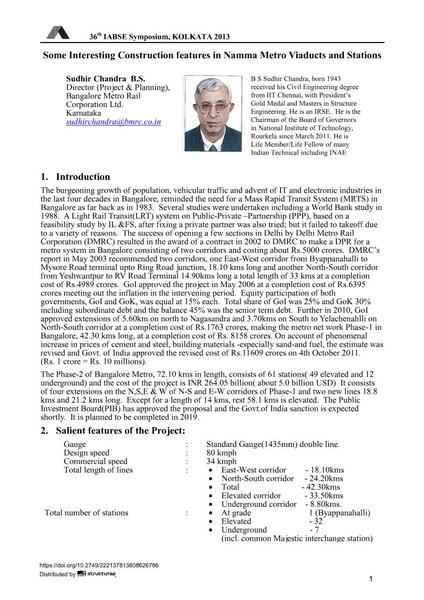Some Interesting Construction features in Namma Metro Viaducts and Stations

|
|
|||||||||||
Bibliographic Details
| Author(s): |
Sudhir Chandra B. S.
|
||||
|---|---|---|---|---|---|
| Medium: | conference paper | ||||
| Language(s): | English | ||||
| Conference: | IABSE Symposium: Long Span Bridges and Roofs - Development, Design and Implementation, Kolkata, India, 24-27 September 2013 | ||||
| Published in: | IABSE Symposium Kolkata 2013 | ||||
|
|||||
| Page(s): | 1-12 | ||||
| Total no. of pages: | 12 | ||||
| Year: | 2013 | ||||
| DOI: | 10.2749/222137813808626786 | ||||
| Abstract: |
The burgeoning growth of population, vehicular traffic and advent of IT and electronic industries in the last four decades in Bangalore, reminded the need for a Mass Rapid Transit System (MRTS) in Bangalore as far back as in 1983. Several studies were undertaken including a World Bank study in 1988. A Light Rail Transit(LRT) system on Public-Private –Partnership (PPP), based on a feasibility study by IL &FS, after fixing a private partner was also tried; but it failed to takeoff due to a variety of reasons. The success of opening a few sections in Delhi by Delhi Metro Rail Corporation (DMRC) resulted in the award of a contract in 2002 to DMRC to make a DPR for a metro system in Bangalore consisting of two corridors and costing about Rs.5000 crores. DMRC’s report in May 2003 recommended two corridors, one East-West corridor from Byappanahalli to Mysore Road terminal upto Ring Road junction, 18.10 kms long and another North-South corridor from Yeshwantpur to RV Road Terminal 14.90kms long a total length of 33 kms at a completion cost of Rs.4989 crores. GoI approved the project in May 2006 at a completion cost of Rs.6395 crores meeting out the inflation in the intervening period. Equity participation of both governments, GoI and GoK, was equal at 15% each. Total share of GoI was 25% and GoK 30% including subordinate debt and the balance 45% was the senior term debt. Further in 2010, GoI approved extensions of 5.60km on north to Nagasandra and 3.70kms on South to Yelachenahlli on North-South corridor at a completion cost of Rs.1763 crores, making the metro net work Phase-1 in Bangalore, 42.30 kms long, at a completion cost of Rs. 8158 crores. On account of phenomenal increase in prices of cement and steel, building materials -especially sand-and fuel, the estimate was revised and Govt. of India approved the revised cost of Rs.11609 crores on 4th October 2011. (Rs. 1 crore = Rs. 10 millions). |
||||
| Keywords: |
metro station metro viaduct
|
||||
